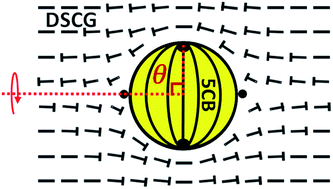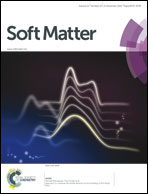Hierarchical organization in liquid crystal-in-liquid crystal emulsions†
Abstract
We report the formation and characterization of hierarchical ordering in systems comprised of micrometer-sized droplets of thermotropic nematic liquid crystals (LCs) dispersed in continuous nematic phases of a lyotropic chromonic LC (disodium cromoglycate (DSCG)). Significantly, we find the orientations of the two LC phases to be coupled, with nematic droplets of 4′-pentyl-4-cyanobiphenyl (5CB) exhibiting a bipolar configuration with an axis of symmetry aligned orthogonal to the far-field director of the DSCG phase. We determine that this coupling of orientations does not result from either anisometric LC droplet shape or interfacial ionic phenomena but rather is consistent with the influence of van der Waals interactions that arise from the anisotropic polarizabilities of nematic 5CB (Δn = +0.18) and DSCG (Δn = −0.02) phases. We also find that it is possible to rotate and uniformly align the nematic droplets by using a weak magnetic field (B ∼ 0.3 T). An analysis of the dynamics of relaxation of the orientations of the 5CB droplets following removal of the magnetic field reveals the DSCG and 5CB droplets to be coupled by energies of ∼104 kT, consistent with a simple theoretical estimate of the influence of anisotropic van der Waals interactions. We also observed the nematic 5CB droplets to form dimers and larger assemblies mediated by the elasticity of the nematic DSCG. Overall, these results reveal that LC-in-LC emulsions define a new class of hierarchically ordered soft matter in which both thermotropic and lyotropic LCs are coupled in their ordering.


 Please wait while we load your content...
Please wait while we load your content...